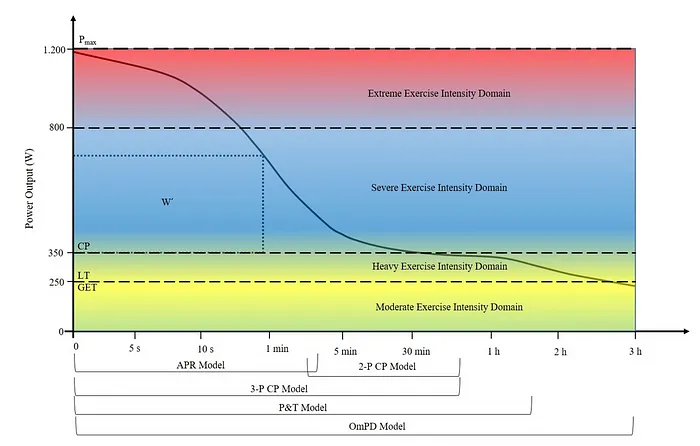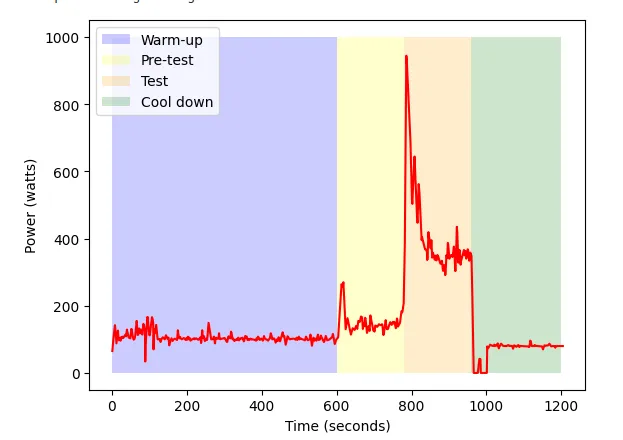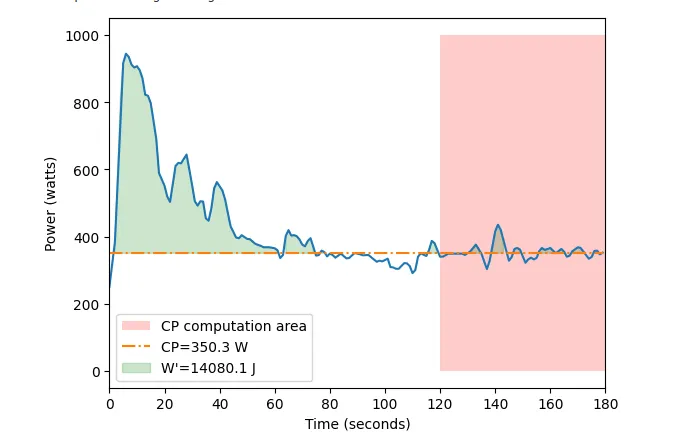The 3-Minute All-Out Test: A Field-Friendly Approach to CP and W’ Assessment with Data and Code
Introduction
In a previous blog post, we discussed the metrics used to quantify performance and prescribe training intensity. Critical Power (CP) is the most promising one. This short article will detail a modified version of a test used to determine Critical Power and work capacity W’. It is important to note that this test must be interpreted cautiously, especially for elite athletes. The Critical Power (CP) and W’, the work capacity above CP, can be easily visualized using the time to task failure (TTF) versus power, as CP represents the asymptote of the curve, and W’ represents the area under the curve but above CP. This curve is known to be hyperbolic and can be established by recording the maximum power output produced during a maximum effort for a given duration. Here, we will present a variant of the 3-minute all-out test to compute CP and W’ on the field.

3 minutes all-out test
The 3-minute all-out test is a one-time test where the candidate pedals as fast as possible without regulation. The rationale is that W’ is fully depleted during the first 150 seconds of the test, and therefore, only the CP can be sustained in the last 30 seconds. In the lab, it is performed on an ergometer where the resistance needs to be defined. For this purpose, the candidate will undergo a pre-test to estimate CP and their preferred cadence, so the ergometer can be set as follows: “The resistance on the pedals during the 3-minute effort was set using the linear mode of the ergometer so that the subjects would attain the power output halfway between VO2peak and the gas exchange threshold on reaching their preferred cadence (linear factor = power/cadence squared).” Few athletes can access an ergometer, and the setup can be cumbersome. A modified version of this test can be done using a regular smart trainer at home with some analysis.
Setup
For this test, the smart trainer will be set in Level Mode. Level Mode applies a standard resistance curve to the trainer, replicating outdoor riding: the faster you go, the greater the resistance. The level of resistance should be set as follows:
- Select a level that allows you to reach your maximum 10-second power output.
- Select a level where you can achieve your CP estimate at your preferred cadence, enabling you to maintain your preferred cadence during the last 60 seconds of the test without the need for frequent gear changes.
Test
The subject will begin the test with a 10-minute warm-up at approximately 100 watts, followed by 3 minutes at their preferred cadence, and then perform the all-out test. The all-out test should be performed without restraint. When executed correctly, the first few seconds should approach the maximum sprint value, after which the power will gradually decrease, and the final 60 seconds should be sustained at the CP value. See Figure 1 for a representation of the test session.

Analysis
The analysis of this test is relatively straightforward. Critical Power (CP) is calculated as the average power output during the last 30 seconds of the test, while the work capacity above CP, denoted as W’, is determined by computing the work done above CP.

Figure 2 presents the results of a 3-minute all-out test following the earlier protocol. Firstly, it can be observed that, unlike tests performed on an ergometer, the power output is more susceptible to rapid variations that correlate with gear shifting. Cyclists tend to sustain power output until their cadence drops, after which they downshift, as depicted in Figure 3. Transitions out of the saddle can also contribute to these surges in power.

The Critical Power (CP) is computed by averaging the power output over the last 30 seconds of the test, resulting in a value of 350.3 watts. W’, representing the work done above CP during the test, can be calculated by integrating the function (power minus CP) over time when power exceeds CP, resulting in a value of 14 kJ. The maximal power (Pmax) for a one-second effort was measured at 944 watts, with a mean power output of 422 watts over the 180 seconds of the test.
We can use the 3-P CP model, valid for efforts lasting up to 40 minutes, to calculate the power-duration relationship, Figure 4. This relationship is expressed as TTF = W’/(P-CP) + W’/(CP-Pmax), giving us the power that can be sustained for a given duration. This information is valuable for prescribing High-Intensity Interval Training (HIIT) intensities based on the desired duration.

Analysis
The 3-minute all-out test was validated using a protocol performed on an ergometer with recreational athletes. Evidence suggests that this method overestimates CP (Critical Power) and underestimates W’ (work capacity above CP) in well-trained athletes.
In our experiment involving one moderately trained individual (72kg, 323W FTP, 400W MAP determined via ramp test), CP appears to be overestimated, while W’ seems underestimated. In our case, the power-duration relationship looks pretty accurate for relatively short efforts (less than 10 minutes) compared to training data. However, the power output appears to be significantly overestimated for more prolonged efforts (more than 15 minutes).
First, these differences can be explained by the testing method, which results in surges and breaks in power output compared to a test performed on an ergometer. Secondly, the Pmax (maximum power output) is relatively low compared to previously recorded data, and the power output in the last 30 seconds is not well stabilized, showing a slight upward trend. These observations suggest that the first 120 seconds were not performed at maximal output, leading to the low W’ and high CP values.
The 3-minute all-out test is typically robust in terms of pacing but is mentally and physically exhausting. The mental aspect of the test likely significantly impacts its accuracy, especially around the 100-second mark when there is a noticeable power drop correlated with high suffering, where the athlete may become less focused.
Conclusion
The 3-minute all-out test is easy to perform and analyze and can be used to determine CP and W’. It also allows for the application of mathematical models to deduce the power-duration relationship. However, test results should be interpreted cautiously when dealing with well-trained athletes.
In our case, CP seems to be overestimated, and W’ underestimated compared to available training data. These observations can be explained by a drop in power at the 100-second mark and a slight upward trend for the last 40 seconds. It has been demonstrated that several tests, notably the 20-minute FTP test, require a certain level of familiarity before yielding reliable results. Perhaps the same applies to the 3-minute all-out test.
Reference
- [1] P. Leo, J. Spragg, T. Podlogar, J. S. Lawley et I. Mujika : Power profiling and the power-duration relationship in cycling : a narrative review. European journal of applied physiology, p.1–16, 2022.
- [2] A. Chorley et K. L. Lamb : The application of critical power, the work capacity above critical power (w’), and its reconstitution : a narrative review of current evidence and implications for cycling training prescription. Sports, 8(9):123, 2020.
- [3] Vanhatalo, Anni, Jonathan H. Doust, and Mark Burnley. “Determination of critical power using a 3-min all-out cycling test.” Medicine and science in sports and exercise 39.3 (2007): 548–555.